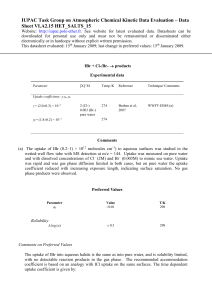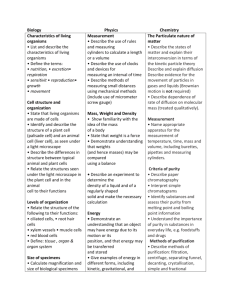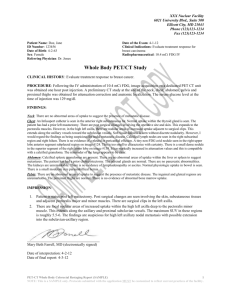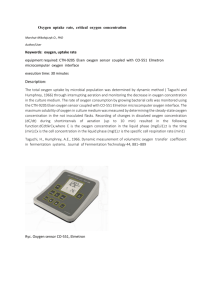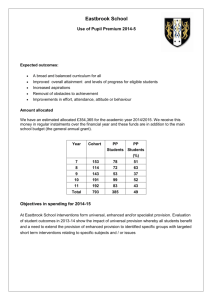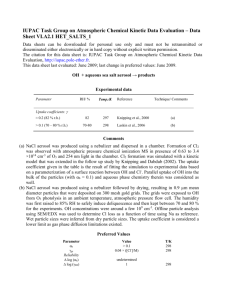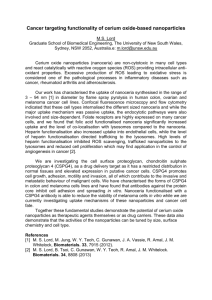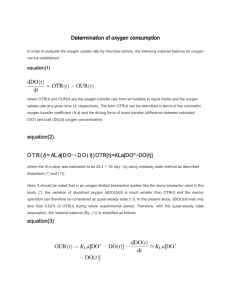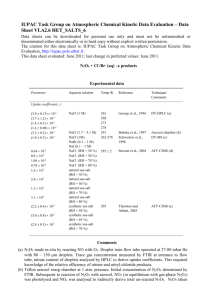Word
advertisement
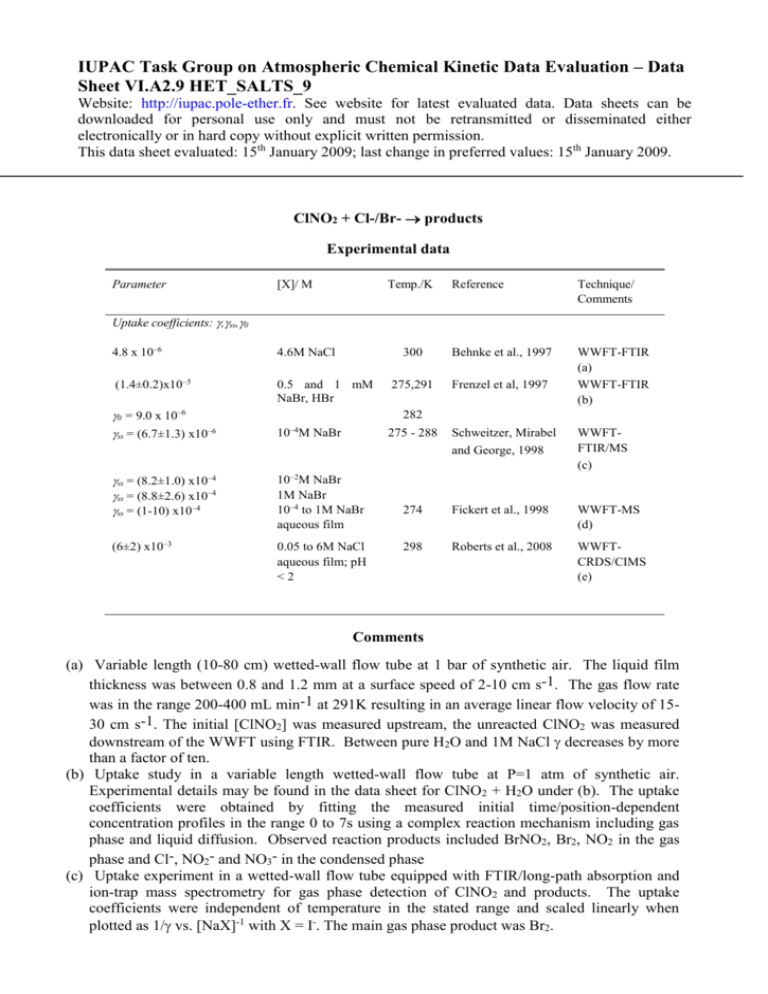
IUPAC Task Group on Atmospheric Chemical Kinetic Data Evaluation – Data Sheet VI.A2.9 HET_SALTS_9 Website: http://iupac.pole-ether.fr. See website for latest evaluated data. Data sheets can be downloaded for personal use only and must not be retransmitted or disseminated either electronically or in hard copy without explicit written permission. This data sheet evaluated: 15th January 2009; last change in preferred values: 15th January 2009. ClNO2 + Cl-/Br- products Experimental data Parameter [X]/ M Temp./K Reference Technique/ Comments 300 Behnke et al., 1997 275,291 Frenzel et al, 1997 WWFT-FTIR (a) WWFT-FTIR (b) Uptake coefficients: ,ss,0 4.8 x 10–6 4.6M NaCl (1.4±0.2)x10–5 0.5 and 1 mM NaBr, HBr 0 = 9.0 x 10–6 ss = (6.7±1.3) x10–6 282 –4 10 M NaBr ss = (8.2±1.0) x10–4 ss = (8.8±2.6) x10–4 ss = (1-10) x10–4 10–2M NaBr 1M NaBr 10–4 to 1M NaBr aqueous film (6±2) x10–3 0.05 to 6M NaCl aqueous film; pH <2 275 - 288 Schweitzer, Mirabel and George, 1998 WWFTFTIR/MS (c) 274 Fickert et al., 1998 WWFT-MS (d) 298 Roberts et al., 2008 WWFTCRDS/CIMS (e) Comments (a) Variable length (10-80 cm) wetted-wall flow tube at 1 bar of synthetic air. The liquid film thickness was between 0.8 and 1.2 mm at a surface speed of 2-10 cm s-1. The gas flow rate was in the range 200-400 mL min-1 at 291K resulting in an average linear flow velocity of 1530 cm s-1. The initial [ClNO2] was measured upstream, the unreacted ClNO2 was measured downstream of the WWFT using FTIR. Between pure H2O and 1M NaCl decreases by more than a factor of ten. (b) Uptake study in a variable length wetted-wall flow tube at P=1 atm of synthetic air. Experimental details may be found in the data sheet for ClNO2 + H2O under (b). The uptake coefficients were obtained by fitting the measured initial time/position-dependent concentration profiles in the range 0 to 7s using a complex reaction mechanism including gas phase and liquid diffusion. Observed reaction products included BrNO2, Br2, NO2 in the gas phase and Cl-, NO2- and NO3- in the condensed phase (c) Uptake experiment in a wetted-wall flow tube equipped with FTIR/long-path absorption and ion-trap mass spectrometry for gas phase detection of ClNO2 and products. The uptake coefficients were independent of temperature in the stated range and scaled linearly when plotted as 1/ vs. [NaX]-1 with X = I-. The main gas phase product was Br2. (d) Uptake study in a wetted-wall tubular flow reactor on a falling film of pure water and aqueous alkali halide salt solutions at 14 to 18 Torr of He as a carrier gas. The reactant was monitored using a differentially-pumped MS. The value of ss remains unchanged upon addition of 1M NaCl whereas it increased upon addition of 0.1M OH-. Analysis of uptake rates measured under gas –phase diffusion controlled conditions (0.5 M KOH film) gave the cited value for the accommodation coefficient on aqueous surfaces, = (9 ± 4) x 10-3. Estimates of the diffusion coefficients DClNO2 in He, N2 and H2O are reported as 275±26, 75±6 and 100±20 Torr cm s-1 respectively. Parameters determining reactive uptake rates into Br- solutions were determined interdependently as H2DlkII = (0.101 ± 0.015) M cm2 s-2. The gas phase products were found to be Br2, BrNO2 and minor amounts of BrCl. Br2 was a secondary reaction product resulting from the condensed phase reaction of BrNO2 with Br-. (e) Uptake study in a tubular flow reactor where N2O5 was converted to ClNO2 by reaction on aqueous slurry of NaCl and the resultant ClNO2 reacted with NaCl/oxalic acid solution at pH =18. Relatively fast uptake of ClNO2 attributed to acid catalysed reaction producing Cl2 as the main product. The reactant N2O5 was monitored by CRDS after thermal-decomposition to NO3. Products were monitored by I--CIMS. Analysis of uptake rates gave an estimate of > 107 M-1s-1 for the rate constant for the reaction of ClNO2 with Cl-. Preferred Values Parameter α Value 0.01 T/K 274 kII (M-1s-1) (Cl; pH < 2) H2DlkII (M cm2 s-2) (Br) >107 0.101 ± 0.015 274 Reliability log (α) ±0.3 Comments on Preferred Values The results of the earlier studies are in broad agreement, and the recent work revealed an important change in mechanism at conditions low pH leading to Cl2 production. The uptake of ClNO2 into the aqueous phase is slow into neutral solutions containing Cl- but is significantly enhanced in acid solutions (pH<2). Cl2 is not formed from neutral solutions but is produced with high yield at pH = 1.8 even at [Cl-] = 0.05 M (Roberts et al. 2008), probably due to an acid catalysed reaction. Uptake is also significantly enhanced on introduction of Br- in the condensed phase, with formation of products BrNO2/Br2 which will partition rapidly to the gas phase. Reactive uptake is controlled by chemical reaction in the bulk, i.e. in terms of the resistance model: ⎧1 ⎫−1 c €= ⎨ + ⎬ where kI = kII x [X-]aq (M, X = Cl- or Br-) 1 0.5 ⎩α 4HRT (Dl k ) ⎭ € The preferred value of b is taken from the work of Fickert et al.(1998). The preferred values for uptake on Cl- are based on the work of Roberts et al.(2008), who used a value of H = 4 x 10-2 M.atm-1 in their analysis. The preferred values for uptake on Br- are based on the thorough analysis reported in the work of Fickert et al. (1998). The liquid phase diffusion coefficient has not been determined but a value of ~ 1 x 10-5 cm2s-1 is normally used. References Behnke, W., George, Ch., Scheer, V. and Zetzsch, C.: J. Geophys. Res. 102, 3795 (1997). Fickert, S., Helleis, F., Adams, J., Moortgat, G.K. and Crowley, J.N.: J. Phys. Chem. 102A, 10689 (1998). Frenzel, A., Scheer, V., Sikorski, R., George, Ch., Behnke, W., and Zetzsch, C.: J. Phys. Chem. 102 1329, (1998). George, Ch., Behnke, W., Scheer, V., Zetzsch, C., Magi, L., Ponche, J.L. and Mirabel, Ph.: Geophys. Res. Lett. 22, 1505 (1995). Roberts, J.M., Osthoff, H.D., Brown, S.S. and Ravishankara, A.R., Sceince, 321, 105, 2008. Schweitzer, F., Mirabel, Ph. and George, Ch., J. Phys. Chem., 102, 1942, 1998
